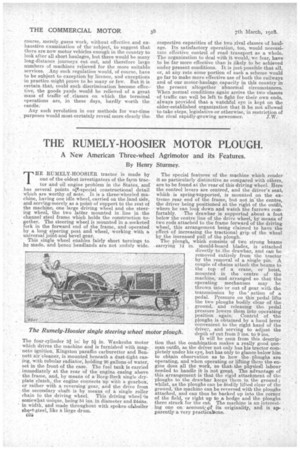THE RUMELY-HOOSIER MOTOR PLOUGH.
Page 16

If you've noticed an error in this article please click here to report it so we can fix it.
A New American Three-wheel Agrimotor and its Features. By Henry Sturmey.
THE RUMELY-HOOSIER tractor is made by one of the oldest investigators of the farm tractor and oil engine problem in the States, and has several points otiaspecial constructional detail v./Lich are worthy of note. It is a three,wbeelecl machine, having one idle wheel, carried on the land side, and servingroerely as a point of support to the rest of the machine, one large driving wheel and ohe steering wheel,. the two latter mounted in line in the channel steel frame which holds the construction together. The steering wheel is mounted in a socketed fork in the forward end of the frame, and operated by a long steering post and wheel, working with a j universal joint and bevel gear. This single wheel enables fairly short turnings to be made, and hence headlands are not nriduly wide.
The four-cylinder n in by 5i in. Waukesha motor which drives the machine and is furnished with maga neto ignition, Kingston paraffin carburetter and Ben ' nett,air-cleaner, is mounted beneath a dust-tight casing, with tubular radiator, holding 26 gallons of water, set in the front of the case: The fuel tank is carried immediately at the rear of the engine casing above the 'frame, and, by means of a Borg-Beek single dry. plate clutch, theengine connects -up with a gearbox, or rather with a reversing 'gear, and the drive from -.the secondary shaft is by means of a single roller chain to the driving wheel. This driving wheel is : sornewhat UniqUe, being 54 ins. in diameter and 244ins. in width, and made throughout with spokes, ofsboiler sheetsteel, like a large drum.
C35 The special features of the machine which render it so particularly distinctive as compared with others, are to be found at the rear of this driving wheel. Here the control levers are .centred, and the driver's seat, which is spring-tupported, is mounted on the extreme rear end of the frame, but not in the centre, the driver being positioned at the right of the outfit, where he can look down and watch the furrows comfortably. The drawbar is supported about a foot below the centre line of the drive wheel,by means of two rods attached to the frame forward of the driving wheel, this arrangement being claimed to have the effect of increasing the tractional grip of the wheel by the increased pull, of the plough. The plough, which consists of two strong beams i carrying 14 n. niould-board blades, is attached directlyto the drawbar, anti can be removed entirely from the tractor by the removal of a single pin. A couple of chains attach the beams to' the top of a crane, or hoist, mounted in the centre of the machine, and arranged so that the operating mechanism may be thrown into 'or out of gear with the transmission by the' action of a pedal. Pressure on this pedal lifts the two ploughs bodily clear of the. ground, and releasing the pedal pressure lowers them into operating position again. . Control of the ploughs is obtained by a hand lever convenient to the right hand of the drive; and serving to adjust the ins.
otor plough.
It wilt be seen from this description that the 'combination makes. a really good oneman outfit, as the driver not only has his tractor completely under his eye, but has only to glance below him to obtain observation as to how the ploughs are operating, and when operating or lifting them the engine does all the work, so thata the ph.ysical labour needed to handle it is not great. The advantage of this arrangement is that the rigid attachment of the ploughs to the drawbar keeps them in the ground ; whilst, as -the ploughs can be bedily lifted clear of the ground, the machine can be reversed with the ploughs attached, and can thus be backed up into the corner of the field, or right up to a hedge and the ploughs there struck for the cut. The machine is an interesting one on aceount4 pf its originality, and is apparently a very practicabone.






















